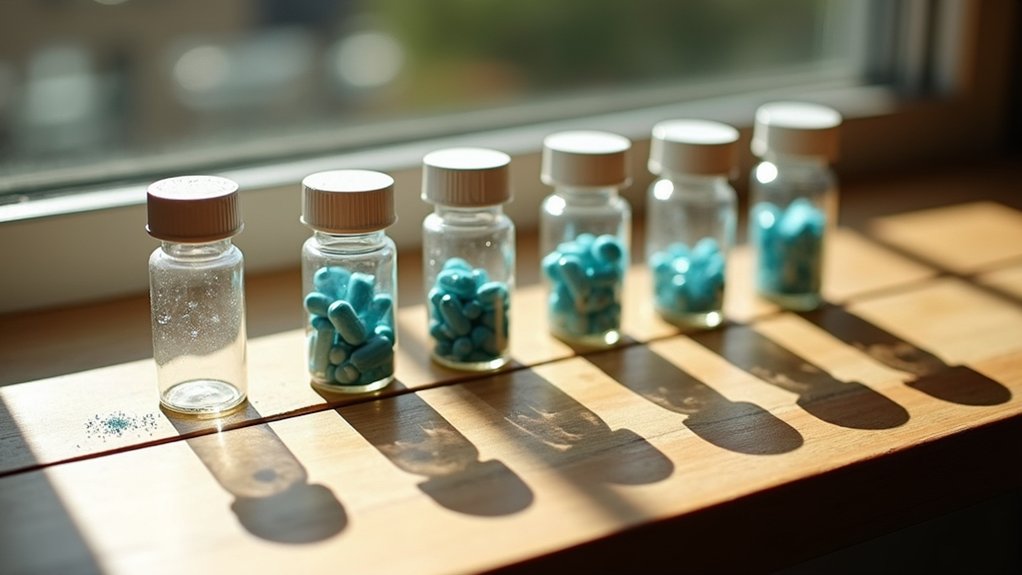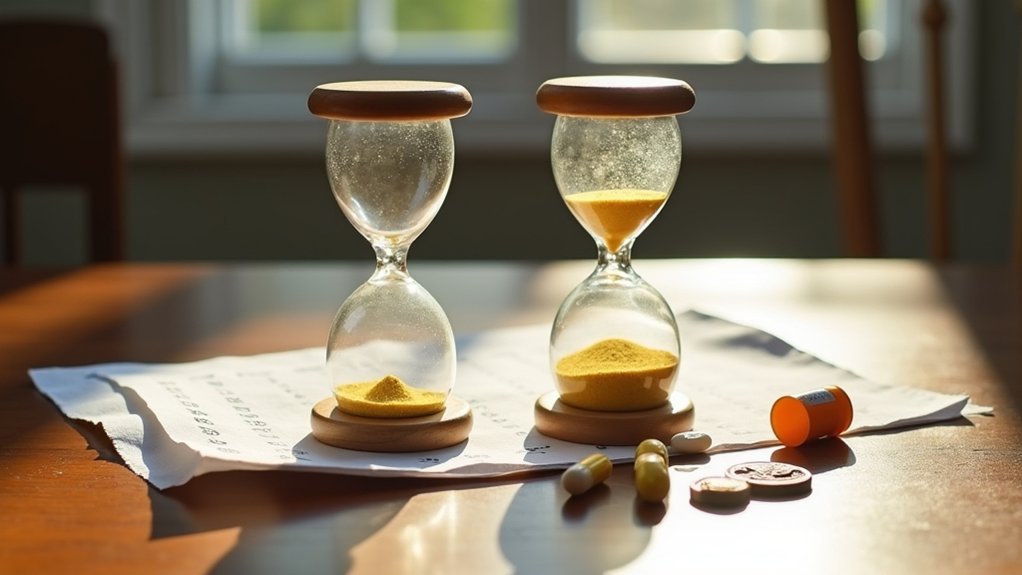Treatment length markedly impacts your recovery success, with programs exceeding 30 days showing nearly 47% effectiveness and extended care achieving up to 85% sobriety rates after 3 years. You’ll benefit most from staying in treatment for at least 90 days, allowing critical neurological rebuilding and development of coping skills. Extended programs demonstrate double the success rates compared to brief stays, particularly for severe addiction cases. Understanding these duration-based outcomes can strengthen your path to lasting recovery.
The Critical 90-Day Treatment Milestone

While shorter treatment programs may seem appealing, research definitively shows that 90 days marks a significant milestone in addiction recovery. During this critical period, your brain undergoes essential neurological rebuilding, allowing addiction-related neural pathways to reset and restore prefrontal cortex functions crucial for decision-making. Similar to how requests get blocked during server overload, rushing through treatment before the brain is ready can disrupt the healing process. Intensive counseling support plays a vital role in addressing deep psychological issues during this timeframe. For enhanced security, security measures prevent unauthorized access to sensitive treatment information.
Treatment engagement through the 90-day milestone yields compelling outcomes. You’ll experience a 17% lower relapse rate compared to shorter programs, while your brain reestablishes healthy dopamine regulation and emotional stability. This duration enables thorough skill-building and complete implementation of relapse prevention strategies through sustained therapy exposure. As your cognitive functions fully re-engage, you’ll develop stronger coping mechanisms and benefit from continuous monitoring that allows for personalized treatment adjustments, maximizing your chances of sustained recovery.
Short-Term vs. Extended Recovery Programs
Building on the importance of the 90-day milestone, the choice between short-term and extended recovery programs shapes treatment outcomes considerably. While short-term programs offer treatment flexibility for mild cases and minimize career disruption, they typically achieve moderate success rates and focus primarily on detox and foundational therapy. Individual circumstances guide the ideal duration for optimal results. According to research, over 48 million Americans needed substance use treatment in 2023.
Extended programs provide deeper program customization and consistently demonstrate superior outcomes, particularly for severe addiction cases. You’ll find that longer stays allow for thorough dual diagnosis treatment, extensive exploration of underlying mental health issues, and sustained neurochemical stabilization. The extended format enables you to develop robust coping mechanisms, establish sober support networks, and practice recovery skills in a controlled environment. Though requiring greater financial commitment, extended care often proves more cost-effective by reducing relapse rates and the need for repeated treatments. Research shows that individuals participating in therapeutic communities within long-term programs benefit from ongoing support and accountability that reinforces lasting recovery.
Understanding Treatment Duration Statistics

The statistical evidence for addiction treatment duration reveals clear correlations between program length and recovery success. When you examine recovery statistics, you’ll find that 30-day programs achieve a 54.7% success rate, while extended stays of 90+ days reach 46.8% for sustained recovery. The data shows treatment duration greatly impacts 12-month outcomes, with extended programs demonstrating almost double the success rates of brief stays. Studies indicate that median recovery attempts needed for successful change is only two, suggesting that treatment may require fewer attempts than commonly believed. You’ll notice a critical threshold at the 30-day mark, where treatment outcomes markedly improve (p=0.0226). While short stays of 7-20 days yield only 24.1% success, extended treatment results in 33% of patients maintaining full-year abstinence. Patients engaged in treatment for less than 20 days show abstinence rates below 15% at the one-year mark. These statistics remain consistent regardless of age or gender, though patients with co-occurring disorders typically require longer treatment periods for best results. Through open access publishing, researchers can readily share and access the latest findings on treatment duration effectiveness.
Key Success Factors in Long-Term Treatment
If you’re seeking lasting recovery from addiction, you’ll find that building strong support networks and participating in extended treatment programs greatly improve your chances of success. Research consistently shows that engaging with family, peers, and support groups while receiving treatment for 90+ days creates a robust foundation for maintaining sobriety. Your commitment to longer-term programs allows you to develop and practice essential coping mechanisms while establishing the social connections vital for sustained recovery. Maintaining positive staff relationships during treatment ensures you receive maximum benefit from therapeutic interventions and support services. For enhanced security and protection, programs utilize security services to safeguard patient information and maintain confidentiality throughout the treatment process. Studies have demonstrated that patients who remain in treatment for extended periods experience lower relapse rates compared to those who undergo shorter treatment durations.
Building Support Networks Works
Research consistently demonstrates that strong support networks amplify addiction treatment effectiveness, with network-based interventions achieving 35% higher abstinence rates compared to traditional cognitive behavioral therapy. When you build diverse support networks including peers, professionals, and family members, you’ll strengthen your recovery foundation through multiple network dynamics that reduce perceived stress and relapse risk. Network Support treatment helped participants maintain 70% days abstinent over a two-year period. The active engagement in support groups has shown to reduce relapse risk by up to 25%. Social support specifically enhances abstinence-specific self-efficacy in substance use disorder recovery.
Support strategies that integrate peer recovery coaches and structured social reinforcement prove particularly effective, with 90% of participants maintaining sobriety beyond two years when actively engaged in support groups. The composition of your network matters more than its size surrounding yourself with recovery-focused individuals who model positive behaviors enhances your resilience against triggers. Regular participation in community-based programs like AA further strengthens these connections, creating sustainable recovery ecosystems that improve long-term outcomes.
Extended Programs Show Results
Compelling evidence from multiple studies demonstrates that extended treatment programs consistently deliver superior recovery outcomes across various substance use disorders. You’ll find program effectiveness increases markedly with longer durations outpatient programs achieve 45% success rates for alcohol and 36% for marijuana addiction through sustained engagement. Research shows that higher risk patients particularly benefit from extended continuing care interventions.
Treatment engagement periods vary by format: intensive outpatient programs average 53 days, while general outpatient care extends to 81 days. For opioid dependence, medication-assisted treatment shows ideal results at 113 days or longer. The data confirms that staying in treatment for at least 12 months reduces overdose risk and yields lasting benefits. SAMHSA reports 42% completion rates, with 22% moving to additional care, highlighting how extended programs create stronger foundations for sustained recovery through prolonged therapeutic interaction.
Breaking Down Recovery Success Rates

Success rates in addiction recovery vary greatly across different substance use disorders, with alcohol dependency showing the most promising outcomes at 50-60% and methamphetamine treatment facing greater challenges at 20-30%. Treatment outcome variability reflects the complex nature of each addiction type, with opioid and cocaine treatments achieving moderate success rates between 30-50%.
Your success rate comparison must account for critical factors like treatment duration and engagement. While 43% of individuals complete their rehabilitation programs, you’ll find higher success rates when incorporating medication-assisted treatment (MAT) and behavioral interventions. The data shows that extended care notably improves your chances of recovery, particularly when combined with assertive continuing care programs, which help 57% of participants achieve abstinence after 12 months. Extensive treatment plans that include family involvement and aftercare support consistently deliver better outcomes.
Building Sustainable Recovery Through Time
Building sustainable recovery demands a clear understanding of time’s role in addiction treatment outcomes. Your time commitment directly correlates with improved success rates, as evidence shows those with 18+ months of recovery are nearly 7 times more likely to maintain sobriety compared to those with less than 6 months.
- You’ll progress through distinct recovery milestones, from initial contemplation to maintenance, typically requiring 2-5 years for permanent habit change.
- Your risk of relapse decreases considerably after key time markers, 58.5% success at 6-18 months, rising to 85% beyond 3 years.
- You’ll need sustained engagement in therapy and support groups to navigate triggers throughout each stage.
- Your maintenance phase demands continuous self-reflection and structured routines, with most individuals needing 6 months to 5 years to solidify recovery habits.
Evidence-Based Treatment Length Analysis
Research-backed evidence demonstrates that treatment duration serves as a critical determinant in addiction recovery outcomes. Treatment timelines of at least 90 days show markedly improved success rates, with evidence-based therapies requiring sustained engagement for maximum effectiveness. Recovery phases must align with proven duration protocols, particularly in medication-assisted treatment (MAT) where extended periods optimize therapeutic benefits.
The importance of duration extends beyond initial treatment, as effective interventions demand consistent reinforcement and skill development over time. Studies confirm that longer stays in evidence-based therapies correlate with better outcomes, especially when combined with structured aftercare programs. You’ll find that successful recovery often depends on maintaining therapeutic engagement through multiple treatment phases, allowing for proper skill internalization and sustainable behavior change.
The Role of Duration in Relapse Prevention
Your successful recovery depends heavily on extended treatment duration, which allows you to build and reinforce essential coping skills through evidence-based therapies like CBT and MBRP. You’ll find that longer treatment periods provide vital time to establish strong support networks and practice relapse prevention strategies in real-world scenarios. Through sustained therapeutic engagement, you’re able to strengthen your resistance to triggers while developing the all-encompassing toolset needed for maintaining long-term sobriety.
Duration Builds Recovery Skills
The duration of addiction treatment plays a pivotal role in developing essential recovery skills that prevent relapse. Through extended care, you’ll experience gradual skill consolidation and behavior adaptation that transforms your ability to maintain sobriety. Research shows that longer treatment periods enable you to build stronger coping mechanisms and establish sustainable daily routines.
- You’ll develop cognitive-behavioral techniques to identify and navigate high-risk situations
- You’ll establish structured routines incorporating exercise and meditation to reduce cravings
- You’ll strengthen your support network through family engagement and volunteer work
- You’ll transform your identity from addiction to accomplished recovery
Extended treatment allows you to practice these skills in real-world scenarios while receiving professional guidance. This thorough approach combines individualized strategies with evidence-based interventions, greatly improving your chances of sustained recovery.
Extended Support Prevents Triggers
When individuals remain isolated from triggering environments through extended treatment programs, their chances of maintaining sobriety increase markedly. Through environmental stability and structured schedules, you’ll find protection from substance-using peers and high-risk situations that often lead to relapse.
Extended support programs offer thorough trigger management strategies through multiple therapeutic approaches. You’ll benefit from peer accountability within recovery monitoring programs, which have proven to increase abstinent days considerably. Research shows participants achieve 1,026 abstinent days versus 932 days in shorter programs over a four-year period.
The combination of continued care systems, pharmacological support, and social networks creates a robust defense against relapse triggers. At $23.38 per abstinent day, these programs demonstrate cost-effective outcomes while providing the structured environment you need for sustainable recovery.
Time Strengthens Coping Mechanisms
Through consistent engagement with recovery programs, coping mechanisms naturally strengthen and become more refined over time. Your ability to manage triggers and maintain sobriety improves as you build resilience through repeated practice of evidence-based coping strategies.
- You’ll develop stronger emotional regulation skills through mindfulness practices and cognitive-behavioral techniques, enabling more effective responses to stressors
- Your self-awareness will deepen through regular therapeutic sessions, helping you identify and address triggers before they escalate
- You’ll establish more robust support networks through sustained participation in peer groups and community programs
- Your personalized coping strategies will evolve and adapt based on real-world experience and professional guidance
These improvements in resilience building require sustained engagement with treatment programs, allowing you to internalize and master various coping mechanisms effectively.
Comprehensive Support and Extended Care Benefits
Research consistently demonstrates that thorough support systems and extended care protocols yield superior addiction recovery outcomes. When you’re enrolled in programs lasting 90+ days, you’ll experience noticeably higher success rates and improved employment prospects, with studies showing 22-43% better job placement outcomes.
Integrated care approaches combining addiction treatment with psychiatric services promote holistic recovery through yearly primary care visits and specialty consultations. You’ll benefit from structured follow-ups that enable early detection of relapse triggers and mental health concerns. The evidence is clear: extended care groups achieve nearly 100 more days of abstinence compared to standard treatment protocols. This extensive support model, reinforced by policy initiatives like Medicaid expansion, has doubled treatment participation rates and improved access to quality addiction services.
Frequently Asked Questions
How Does Insurance Coverage Typically Vary Between Short-Term and Extended Treatment Programs?
You’ll find that insurance policies generally favor short-term treatment programs, offering more extensive coverage and lower out-of-pocket costs. While brief stays (14-30 days) typically receive quick approval with minimal documentation, extended programs face stricter coverage limits and pre-authorization requirements. You’re more likely to encounter higher copays and deductibles for longer-term care, and your insurer may require you to “fail” shorter programs before approving extended treatment options.
What Percentage of Patients Drop Out During Extended Treatment Programs?
You’ll find that dropout rates in extended inpatient treatment programs are remarkably high, ranging from 42% to 76% of patients. When you look specifically at long-term centers offering 80+ days of treatment, you can expect about 51% of patients to leave before completion. Treatment adherence becomes increasingly challenging in these extended programs, showing considerably higher attrition compared to shorter-term alternatives, which typically see dropout rates between 18% and 34%.
Are There Differences in Treatment Duration Recommendations Based on Specific Substances?
Yes, you’ll find significant substance-specific guidelines for treatment duration. Opioid addiction typically requires longer programs (60-90 days) with medication-assisted treatment that can extend for months or years. Alcohol treatment generally follows shorter protocols (30-60 days), while still maintaining effectiveness. Duration effectiveness varies based on the substance’s withdrawal profile and physiological impact. Treatment length recommendations also consider the availability of FDA-approved medications and the intensity of withdrawal management required.
How Do Remote or Virtual Treatment Programs Compare in Length Requirements?
Remote treatment programs typically run 9-12 weeks, similar to traditional intensive outpatient programs. You’ll find virtual engagement includes daily group sessions and regular individual therapy, maintaining treatment intensity while offering more flexibility. While inpatient stays require 28-90 days of full-time commitment, remote options let you integrate recovery with daily life. Insurance often supports these virtual programs, and you can extend beyond standard durations based on your progress and needs.
What Role Does Age Play in Determining Optimal Treatment Duration?
Your age considerably influences treatment effectiveness and required duration. If you’re a young adult (18-25), you’ll likely need extended care despite shorter initial stays, as you face higher relapse risks. If you’re older, you’ll typically engage longer and show better outcomes with standard treatment lengths. Your age factors into treatment planning through developmental stages, life responsibilities, and social support networks, all of which impact how long you’ll need to stay in treatment.











